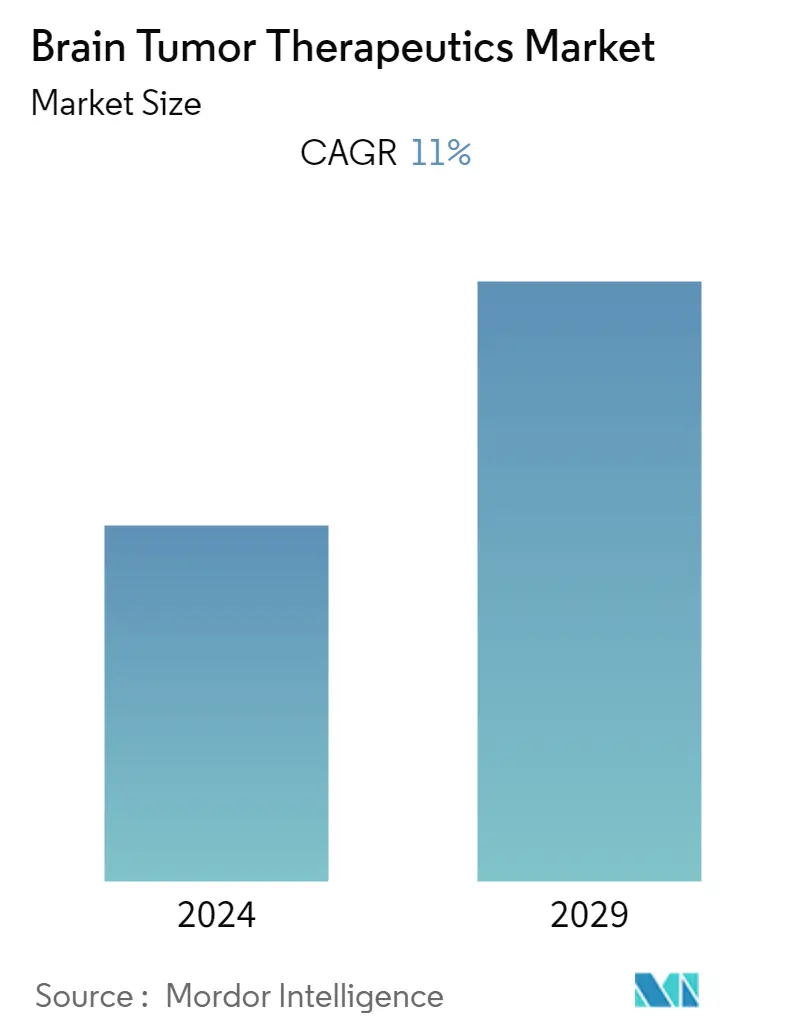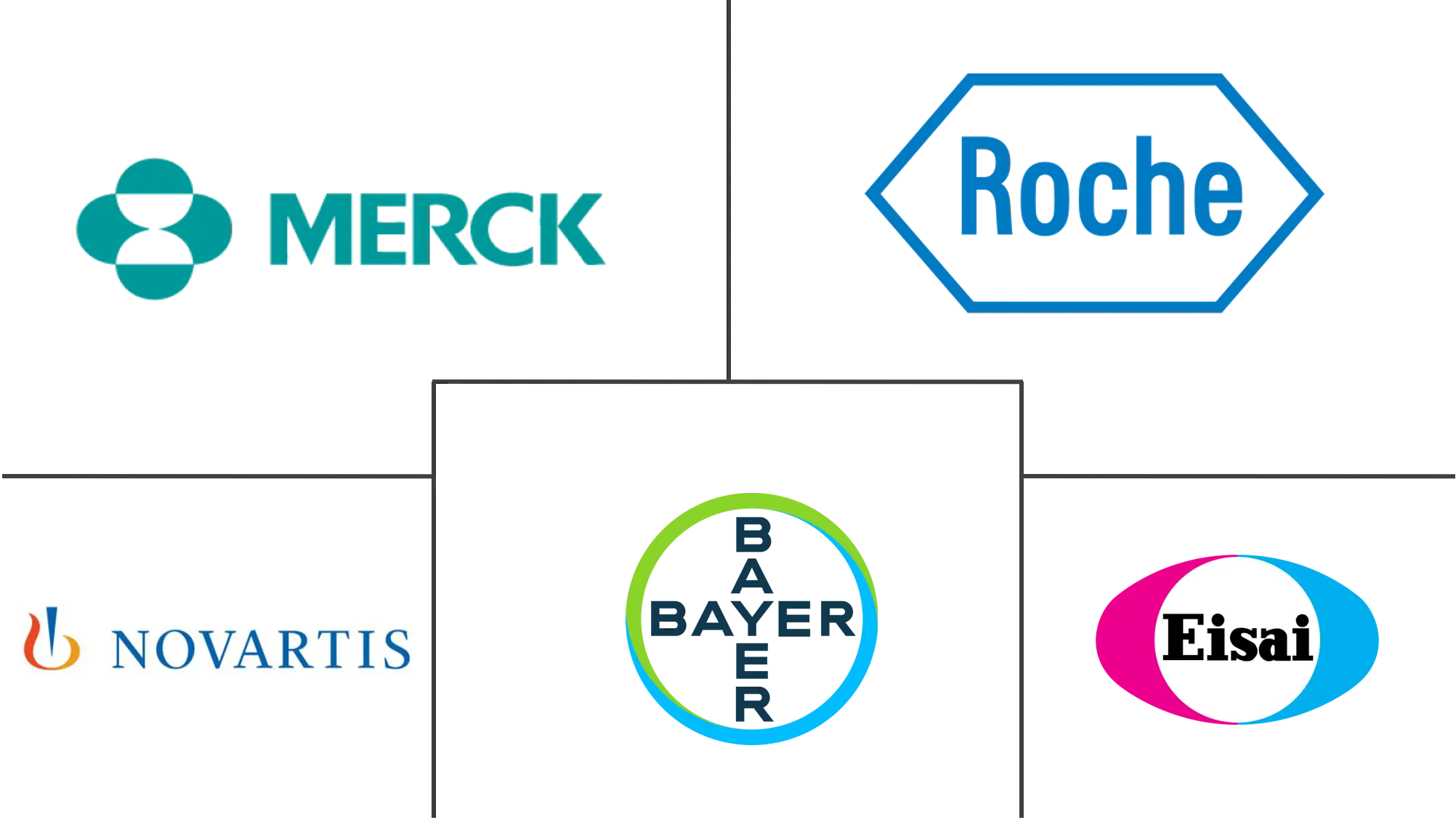Market Size of Brain Tumor Therapeutics Industry

| Study Period | 2019 - 2029 |
| Base Year For Estimation | 2023 |
| CAGR | 11.00 % |
| Fastest Growing Market | Asia Pacific |
| Largest Market | North America |
| Market Concentration | High |
Major Players
*Disclaimer: Major Players sorted in no particular order |
Brain Tumor Therapeutics Market Analysis
The brain tumor therapeutics market is valued at USD 2.70 billion and is expected to reach to USD 4.5 billion registering a CAGR of 11.0% during the forecast period.
COVID-19 impacted the brain tumor therapeutics market significantly due to the delayed diagnosis and scarcity of medications. For instance, as per the article published in January 2021 in Elsevier, a delay or modification in therapy compromised the effectiveness and lowered patients' survival rates. Also, delayed diagnosis of brain tumors was correlated with a worse prognosis. This further impacted the growth of the brain tumor therapeutics market during the pandemic. However, the market is anticipated to grow in the coming years due to the rise in brain tumor cases and increased research and development for brain tumor therapeutics.
Factors such as the rise in brain tumor cases, increased brain tumor therapeutics product launches, and a surge in cancer awareness campaigns focusing on the importance of brain tumor medications are anticipated to boost market growth over the forecast period. For instance, per the NBTS, an estimated 94,390 people in the United States will likely receive a primary brain tumor diagnosis in 2023. This increase in cancer cases is expected to drive the overall brain therapeutics market. Glioblastoma is an aggressive form of brain tumor that occurs mainly in adults. It can also occur in children, but very rarely. It grows fast and spreads quickly. Quick diagnosis and treatment are necessary, as it is a fatal disorder. Proper diagnosis and therapies can alleviate the complications associated with the disease. Hence, as the number of glioblastoma cases increases, the demand for brain tumor therapeutics rises, boosting market growth over the forecast period.
Furthermore, an increase in research and development, product launches, and collaborations by the key players are anticipated to drive market growth. For instance, in June 2022, The FDA approved the combination of the targeted drugs dabrafenib (Tafinlar) and trametinib (Mekinist) for the treatment of people with nearly any type of advanced solid tumor that has a specific mutation in a gene called BRAF. Results from three clinical trials, including two with adult patients and one with pediatric patients, provided the data for approval. Some trial participants had rare cancers, including glioma (brain cancer). In addition, in November 2021, The Ivy Brain Tumor Center at Barrow Neurological Institute and UC San Francisco reported the opening of a Phase 0 clinical trial to evaluate niraparib (ZEJULA), an oral, once-daily poly (ADP-ribose) polymerase (PARP) inhibitor from GSK, for patients with newly diagnosed glioblastoma (GBM) and recurrent glioma (grades II-IV).
Thus, due to the increase in the prevalence of brain tumors and the rise in research and development in the field of brain tumor therapeutics development, the brain tumor therapeutics market is anticipated to witness growth over the forecast period. However, the high cost of cancer therapy and side effects associated with brain tumor therapeutics are projected to hamper market growth over the forecast period.
Brain Tumor Therapeutics Industry Segmentation
As per the report's scope, brain tumor arises from the abnormal growth of cancerous cells in the brain. A brain tumor is one of the leading causes of death globally. Meningioma is the most common kind of brain tumor and the hardest to treat, while treatments for glioma usually have better outcomes. The Brain Tumor Therapeutics Market is Segmented by Type of Brain Cancer (Glioblastoma, Meningioma, Pituitary Tumors, and Other Types of Brain Cancer), Therapy (Chemotherapy, Immunotherapy, Gene Therapy, and Other Therapies), and Geography (North America, Europe, Asia-Pacific, Middle East and Africa, and South America). The report also covers the estimated market sizes and trends for 17 countries across major regions globally. The report offers the value (in USD) for the above segments.
| By Type of Brain Cancer | |
| Glioblastoma | |
| Meningioma | |
| Pituitary Tumors | |
| Other Types of Brain Cancer |
| By Therapy | |
| Chemotherapy | |
| Immunotherapy | |
| Gene Therapy | |
| Other Therapies |
| Geography | ||||||||
| ||||||||
| ||||||||
| ||||||||
| ||||||||
|
Brain Tumor Therapeutics Market Size Summary
The brain tumor therapeutics market is poised for significant growth, driven by an increase in brain tumor cases and advancements in research and development. The market, which has been impacted by the COVID-19 pandemic due to delays in diagnosis and treatment, is expected to recover and expand as awareness and demand for effective therapies rise. The prevalence of aggressive brain tumors like glioblastoma necessitates quick diagnosis and treatment, further fueling the demand for therapeutics. The market is also witnessing a surge in product launches and collaborations among key players, which are expected to contribute to its growth over the forecast period. Despite challenges such as high treatment costs and potential side effects, the market's trajectory remains positive, supported by ongoing innovations and regulatory approvals in brain tumor treatments.
Immunotherapy is emerging as a promising segment within the brain tumor therapeutics market, offering new avenues for treatment beyond traditional methods like chemotherapy and radiation. The adoption of immunotherapies is increasing, bolstered by research funding and product launches aimed at enhancing treatment efficacy and reducing side effects. The development of novel immunotherapy strategies, including collaborations between universities and industry players, is expected to drive market expansion. North America is anticipated to hold a significant share of the market, supported by a developed healthcare infrastructure, high prevalence of brain tumors, and robust research and development activities. The market's competitive landscape is moderately fragmented, with major players like Amgen, AstraZeneca, and Roche actively participating in the development and commercialization of brain tumor therapeutics.
Brain Tumor Therapeutics Market Size - Table of Contents
-
1. MARKET DYNAMICS
-
1.1 Market Overview
-
1.2 Market Drivers
-
1.2.1 Rising Incidence of Brain Tumor
-
1.2.2 Strong R&D Initiatives from Key Players
-
1.2.3 Increasing Government Initiatives for Cancer Awareness
-
-
1.3 Market Restraints
-
1.3.1 High Cost of Cancer Therapies
-
-
1.4 Porter's Five Forces Analysis
-
1.4.1 Bargaining Power of Buyers/Consumers
-
1.4.2 Bargaining Power of Suppliers
-
1.4.3 Threat of New Entrants
-
1.4.4 Threat of Substitute Products
-
1.4.5 Intensity of Competitive Rivalry
-
-
-
2. MARKET SEGMENTATION (Market Size by Value - USD)
-
2.1 By Type of Brain Cancer
-
2.1.1 Glioblastoma
-
2.1.2 Meningioma
-
2.1.3 Pituitary Tumors
-
2.1.4 Other Types of Brain Cancer
-
-
2.2 By Therapy
-
2.2.1 Chemotherapy
-
2.2.2 Immunotherapy
-
2.2.3 Gene Therapy
-
2.2.4 Other Therapies
-
-
2.3 Geography
-
2.3.1 North America
-
2.3.1.1 United States
-
2.3.1.2 Canada
-
2.3.1.3 Mexico
-
-
2.3.2 Europe
-
2.3.2.1 Germany
-
2.3.2.2 United Kingdom
-
2.3.2.3 France
-
2.3.2.4 Italy
-
2.3.2.5 Spain
-
2.3.2.6 Rest of Europe
-
-
2.3.3 Asia-Pacific
-
2.3.3.1 China
-
2.3.3.2 Japan
-
2.3.3.3 India
-
2.3.3.4 Australia
-
2.3.3.5 South Korea
-
2.3.3.6 Rest of Asia-Pacific
-
-
2.3.4 Middle East and Africa
-
2.3.4.1 GCC
-
2.3.4.2 South Africa
-
2.3.4.3 Rest of Middle East and Africa
-
-
2.3.5 South America
-
2.3.5.1 Brazil
-
2.3.5.2 Argentina
-
2.3.5.3 Rest of South America
-
-
-
Brain Tumor Therapeutics Market Size FAQs
What is the current Global Brain Tumor Therapeutics Market size?
The Global Brain Tumor Therapeutics Market is projected to register a CAGR of 11% during the forecast period (2024-2029)
Who are the key players in Global Brain Tumor Therapeutics Market?
Bayer AG, F. Hoffmann-La Roche Ltd, Eisai Inc., Novartis AG and Merck & Co. Inc. are the major companies operating in the Global Brain Tumor Therapeutics Market.

